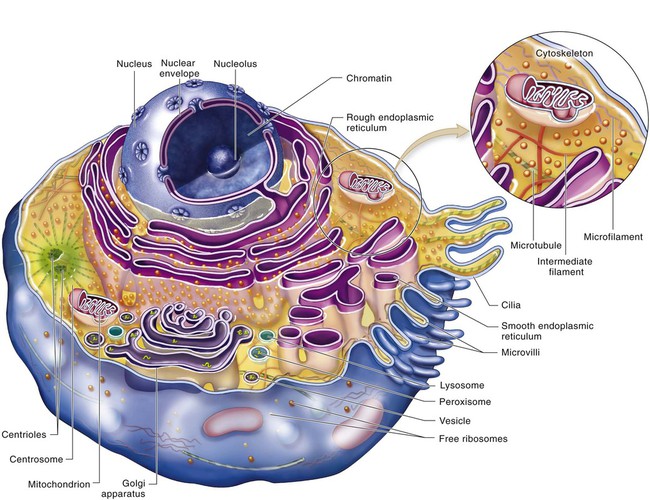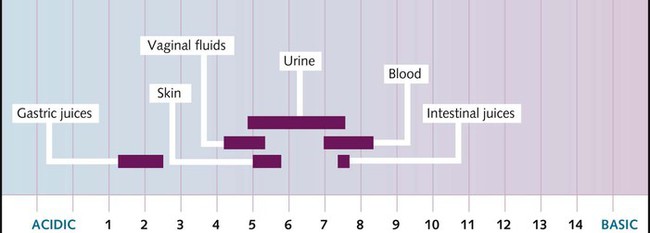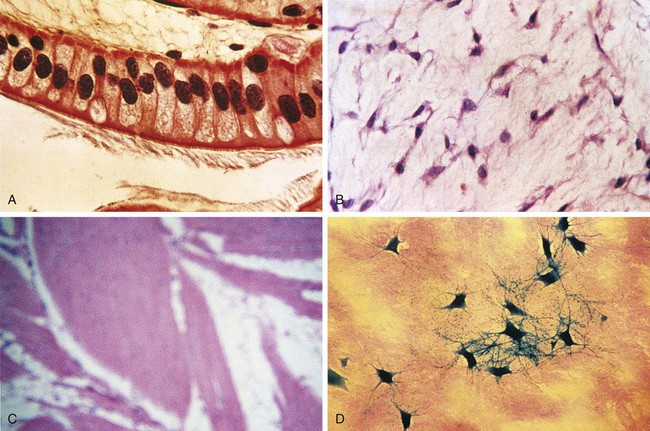Chapter 9 Heredity (he-RED-i-tee) Genetic transmission of trait or particular quality from parent to offspring Body Organization Terminology* *A short transition syllable or vowel may be added to or deleted from the word parts to make the combining form. The human body, like all living organisms, has four basic properties of life: The major structures, called organelles, of the cell are shown in Fig. 9-1. These structures include: Homeostasis is the tendency of a cell or the whole organism to maintain a state of balance. Homeostasis generally refers to maintaining constancy of the “internal milieu,” or fluid surrounding the cells of the organisms. The composition of the tissue fluid that makes up this internal environment is kept constant despite changes in the external environment. Molecules pass into and out of the cell to maintain this balance. Some of the physiologic components of this state of balance include body temperature, gas exchange, pH values, water and ion balance, volume and pressure of fluids, waste removal, and nutrient intake (Table 9-1). TABLE 9-1 Electrolytes are compounds made of charged particles called ions. These ions can conduct electrical current in water or in the cytoplasm of the cell. A positive charge, or cation, creates an acid. A negative charge, or anion, creates a base. The pH of a fluid is a measurement of how much acid or base is present. Each body tissue has a normal pH. The cells do not function properly if the normal pH is not maintained for the area of the body (Fig. 9-2). Different electrolytes also have specific functions, as shown in Table 9-2. TABLE 9-2 The body includes four main groups of tissue (Fig. 9-3).
Body Organization
 Identify the meaning of 10 or more terms relating to the organization of the body.
Identify the meaning of 10 or more terms relating to the organization of the body.
 Describe the properties of life.
Describe the properties of life.
 Label the structures of the cell, and describe the function of each.
Label the structures of the cell, and describe the function of each.
 Describe the organization of the body from the smallest unit to the largest.
Describe the organization of the body from the smallest unit to the largest.
 Describe organs of the body in relation to the plane, region, or cavity of location.
Describe organs of the body in relation to the plane, region, or cavity of location.
 Describe five or more disorders resulting from variations or defects in cell organization.
Describe five or more disorders resulting from variations or defects in cell organization.
Term
Definition
Prefix
Root
Suffix
Abduct
Draw away from the center
ab
duct
Adduct
Draw toward the center
ad
duct
Congenital
Born with
con
gen/it
al
Chemotherapy
Treatment by a chemical agent
chem/o*
therapy
Cytoplasm
Nonorganelle material contained in cells
cyt/o
plasm
Dysfunction
Impairment of function
dys
function
Genetic
Pertaining to genes
gen/et
ic
Genotype
Genetic makeup of an organism
gen/o
type
Physiology
Study of function
physi
ology
Semipermeable
Allowing only some materials to enter and exit
semi
permeable
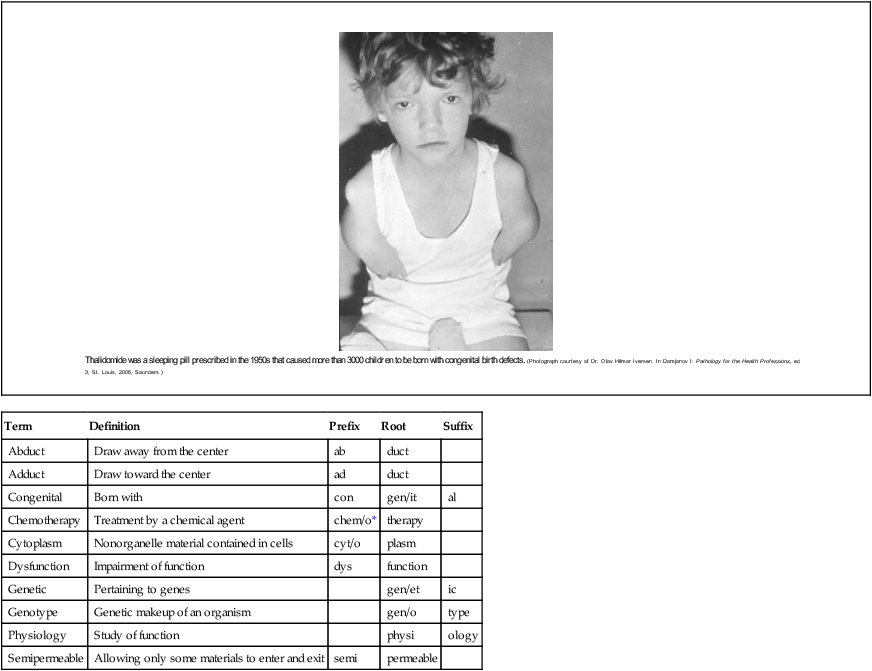
Anatomy and Physiology
 Reception is the ability of the organism to control its actions and respond to changes in the environment.
Reception is the ability of the organism to control its actions and respond to changes in the environment.
 Metabolism is the process of taking in and using nutrients to produce energy and growth.
Metabolism is the process of taking in and using nutrients to produce energy and growth.
 Reproduction is the ability to reproduce offspring to continue the species.
Reproduction is the ability to reproduce offspring to continue the species.
 Organization divides the organism into distinct parts to perform these functions.
Organization divides the organism into distinct parts to perform these functions.
 Cells are the smallest unit of life.
Cells are the smallest unit of life.
 Tissues are combinations of similar cells.
Tissues are combinations of similar cells.
 Organs are collections of tissues working together to perform a function.
Organs are collections of tissues working together to perform a function.
 Body systems consist of organs that work together to provide a major body function.
Body systems consist of organs that work together to provide a major body function.
 Organisms are the beings that result when the body systems work together to maintain life.
Organisms are the beings that result when the body systems work together to maintain life.
Cell Structure
 The nucleus controls the activity of the cell and directs reproduction.
The nucleus controls the activity of the cell and directs reproduction.
 The cytoplasm is a semifluid material that surrounds the cell parts and transports chemicals and nutrients within the cell.
The cytoplasm is a semifluid material that surrounds the cell parts and transports chemicals and nutrients within the cell.
 Mitochondria produce the energy used for cellular processes.
Mitochondria produce the energy used for cellular processes.
 The cell membrane surrounds the cell and controls which substances enter and leave the cell.
The cell membrane surrounds the cell and controls which substances enter and leave the cell.
 Lysosomes help to break down, or digest, molecules.
Lysosomes help to break down, or digest, molecules.
 Ribosomes attached to the rough endoplasmic reticulum work to make protein for the cell structures.
Ribosomes attached to the rough endoplasmic reticulum work to make protein for the cell structures.
 The Golgi apparatus helps to transport proteins made by the ribosomes out of the cell by making glycoproteins.
The Golgi apparatus helps to transport proteins made by the ribosomes out of the cell by making glycoproteins.
 The smooth endoplasmic reticulum makes fats (lipids), steroid hormones, and some carbohydrates.
The smooth endoplasmic reticulum makes fats (lipids), steroid hormones, and some carbohydrates.
Body System
Homeostasis Mechanism
Integumentary
Perspiration helps regulate body temperature.
Cardiovascular
Regulates blood pressure.
Circulatory
Red blood cells transport oxygen and carbon dioxide, as well as hydrogen ions. White blood cells fight infection. Platelets help to clot blood when needed. Nutrients needed by cells and the waste they produce are carried in plasma. Plasma proteins buffer blood to maintain pH. They also create osmotic pressure to remove excess fluid to the heart through lymph vessels.
Respiratory
Oxygen and carbon dioxide are exchanged in the lungs, blood vessels, and cells. Helps regulate pH of blood.
Skeletal
Level of calcium is regulated by parathyroid hormones.
Muscular
Shivering helps regulate body temperature.
Digestive
Digestive enzymes and bile break food down into nutrients. The liver breaks down toxic substances, stores glucose, and destroys old blood cells.
Urinary
Filters the blood to excrete waste products and regulate the amount of water in the body. Blood pressure is affected by fluid balance. Helps regulate pH of blood.
Endocrine
Hormones regulate action of glands that control metabolism, water retention, calcium blood levels, blood sugar, and many other body functions.
Nervous
Receives nutrients from blood. Regulates body temperature, breathing, blood pressure, and autonomic responses.
Sensory
Identifies hunger, pain, and other signs of homeostatic changes.
Reproductive
Oxytocin regulates the strength and frequency of contractions.
Ion
Function
Cations (+)
Sodium (Na+)
Controls water distribution by increasing the ability of fluid to pass through the cell membrane
Potassium (K)
Maintains fluid balance, promotes growth of cells, nerve conduction, muscle contraction, and heart activity
Calcium (Ca+2)
Controls neuromuscular irritability, muscle contraction, and blood clotting; used to build bones and teeth
Magnesium (Mg+2)
Maintains neuromuscular system, activates enzymes, regulates level of phosphorus
Hydrogen (H+)
Needed for cell and enzyme functions, binding of oxygen to hemoglobin
Anions (−)
Bicarbonate (HCO3−)
Maintains acid-base balance
Hydrogen Sulfate (HPO4−2)
Maintains fluid and acid-base balance
Chloride (Cl−)
Maintains fluid balance
Sulfate (SO4−2)
Maintains fluid balance
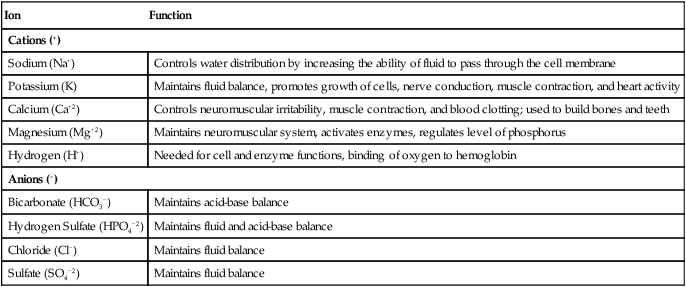
Tissue Types
 Epithelial tissue covers the body, forms glands, and lines the surfaces of cavities and organs.
Epithelial tissue covers the body, forms glands, and lines the surfaces of cavities and organs.
 Connective tissue, formed by a protein, includes soft tissue such as fat and blood cells and hard tissues such as bones, ligaments, and cartilage.
Connective tissue, formed by a protein, includes soft tissue such as fat and blood cells and hard tissues such as bones, ligaments, and cartilage.
 Muscle tissue, made of protein fibers, has the unique property of shortening in length to produce movement.
Muscle tissue, made of protein fibers, has the unique property of shortening in length to produce movement.
 Nervous tissue, composed largely of specialized cells called neurons, is found in the eyes, ears, brain, spinal cord, and peripheral nerves. Nervous tissue transmits communications.
Nervous tissue, composed largely of specialized cells called neurons, is found in the eyes, ears, brain, spinal cord, and peripheral nerves. Nervous tissue transmits communications.
Body Systems
 The integumentary system covers the body and protects other body systems.
The integumentary system covers the body and protects other body systems.
 The cardiovascular system transports oxygen and nutrients to all body parts and removes waste products.
The cardiovascular system transports oxygen and nutrients to all body parts and removes waste products.
 The circulatory system includes the blood and lymph that move throughout the body.
The circulatory system includes the blood and lymph that move throughout the body.
 The respiratory system exchanges gases between the air and blood.
The respiratory system exchanges gases between the air and blood.
 The muscular system allows the body to move and controls movements within the body.
The muscular system allows the body to move and controls movements within the body.
 The skeletal system provides body support and protection.
The skeletal system provides body support and protection.
 The digestive system processes food and eliminates food waste.
The digestive system processes food and eliminates food waste.
 The urinary system filters the blood and removes liquid wastes.
The urinary system filters the blood and removes liquid wastes.
 The endocrine system coordinates body activities through hormones.
The endocrine system coordinates body activities through hormones.
 The nervous system regulates the environment and directs the activities of other body systems.
The nervous system regulates the environment and directs the activities of other body systems.
 The sensory system perceives the environment and sends messages to and from the brain.
The sensory system perceives the environment and sends messages to and from the brain.
![]()
Stay updated, free articles. Join our Telegram channel

Full access? Get Clinical Tree


Body Organization


